Comments / Questions (67)
![]() Mariette wrote:
Mariette wrote:
Mijn proeflapje is na 24 naalden 5 cm. Klopt dat met wat hieronder staat? " De stekenverhouding in de hoogte is opgegeven na de recht gebreide steek, welke wordt gebreid over 1 naald minder dan de averecht gebreide steek, omdat de recht gebreide steek op de rechter naald wordt gezet iedere 2e naald. Met andere woorden, 24 naalden in de hoogte gemeten in de recht gebreide steek op 10 cm staat gelijk aan 48 naalden gemeten in de averecht gebreide steek op 10 cm in de hoogte."
27.11.2018 - 09:05DROPS Design answered:
Dag Mariëtte
Klopt precies zoals je het zegt en je stekenverhouding klopt dus mooi. Maar let er ook op of het breiwerk plat ligt of gedragen wordt. Dit is dus stekenverhouding 1.
28.11.2018 - 12:27
![]() Mariette wrote:
Mariette wrote:
Ik wil graag deze trui gaan breien, maar ik begrijp A1 en A2 niet. Moet ik gewoon A1 breien, en rekt het dan vanzelf uit naar A2?????
25.11.2018 - 17:27DROPS Design answered:
Dag Mariette,
In het patroon staat precies beschreven waar je A.2 moet breien. Deze brei je namelijk op de raglanlijnen. In A.2 zijn namelijk meerderingen voor de raglan verwerkt (stersymbooltje), maar dit is niet op elke naald, maar op iedere 8e naald, waardoor A.2 voor een groot deel op A.1 lijkt.
28.11.2018 - 12:38
![]() Nicole Vena wrote:
Nicole Vena wrote:
My ribbing isn\'t looking like the picture. So I purl, yarn over and slip a stitch off purlwise. Then the next row I purl and knit together the previous yarn over and slipped stitch. Is this correct? I\'ve been doing this for 6 rows and it does look like a rib at all.
24.11.2018 - 20:16DROPS Design answered:
Dear Mrs Vena, the pattern (diagram) is worked in the round, on first round, you work A.1/A.2 as follows: P1, YO, slip 1 as if to P, on next round : P1, K tog the YO and the slipped stitch. This video shows how to increase as explained in the pattern but also how to work A.1/A.2. Happy knitting!
26.11.2018 - 08:49
![]() Anne-Kari Brun wrote:
Anne-Kari Brun wrote:
Jeg kan ikke finne diagrammet. Hvor ligger diagrammet. Mvh Anne-Kari
17.11.2018 - 12:53DROPS Design answered:
Hei Anne-Kari. Diagrammene ligger helt nederst på siden sammen med målskissene. God fornøyelse.
21.11.2018 - 15:29
![]() Claudi wrote:
Claudi wrote:
Liebes Drops-Team Vielen Dank für die Antwort, ich browse normal mit dem Mozilla, was auch dem Anleitungsdruck bisher nicht geschadet hat. Diese Anleitung geht nicht mit dem Mozilla, aber ich hab sie jetzt über den Internet-Explorer ausgedruckt :-) Lieben Dank!
16.11.2018 - 11:59
![]() Claudi wrote:
Claudi wrote:
Hallo liebes Drops-Team Ich drucke mir gerne die Anleitungen aus, was normalerweilse immer einwandfrei funktioniert. Hier wird leider nur die 1. Seite gedruckt. Könntet ihr das bitte ändern? Vielen lieben Dank! Liebe Grüsse Claudi
07.11.2018 - 16:29DROPS Design answered:
Liebe Claudi, leeren Sie den Cache Ihres Browsers und versuchen Sie noch einmal - die Druckeinstellungen mal prüfen damit alle Seiten ausgedruckt werden. Sollte es immer nicht klappen, dann bitte uns mitteilen welchem Browser Sie benutzen. Viel Spaß beim stricken!
08.11.2018 - 08:50
![]() Mireille wrote:
Mireille wrote:
Je trouve ce modèle très beau. Mais les explications me paraissent bien compliquées. Merci de bien vouloir m'expliquer les dessins A.1. et A.2 (p.5, ce sont les diagrammes?) et ce que veut dire "tricoter A.1 (=2 mailles)" ou "tricoter A.2 (= 2 mailles).
01.11.2018 - 22:15DROPS Design answered:
Bonjour Mireille, A.1 et A.2 sont les diagrammes qui se tricotent sur 2 mailles et 8 rangs. Les 7 premiers rangs se tricotent de la même façon: R1, 3, 5 et 7: faites 1 jeté, glissez 1 m à l'env - R2,4,6, et 8 (A.1 seulement): tricotez ensemble à l'end le jeté et la m glissée. Au rang 8 dans A.2, augmentez 4 mailles (cf vidéo). Quand vous devez par ex. tricoter A.1 (= 2 m) au-dessus des 20 m suivantes, vous allez répéter 10 fois A.1 en largeur (= 10 fois 2 m = 20 m). Bon tricot!
02.11.2018 - 07:54
![]() Wies Vossepoel wrote:
Wies Vossepoel wrote:
Ik wil deze trui graag breien en zag nadat ik hem had uitgezocht dat het op rondbreinaalden wordt gebreid. Ik brei liever met 4 naalden zonder knop . Is dat ook mogelijk ?
11.10.2018 - 23:19DROPS Design answered:
Dag Wies, Deze trui is helaas niet zo geschikt om met 4 naalden zonder knop te breien. Omdat je veel steken op de naalden hebt, schuiven ze er namelijk makkelijk af. Met rondebreinaalden breien is in het begin erg lastig, maar het gaat steeds makkelijker, hoe meer je het doet. Het opzetten kun je met rechte naalden doen, waarna je ze op de rondbreinaald schuift.
15.10.2018 - 21:54
![]() Lone wrote:
Lone wrote:
Tak for svar, men spørgsmålet gok ikke på ind- og udtagning. Det går på at keg ikke forstår hvordan diagrammerne A1 ig A2 skal læses? De har vel ikke noget med ind- og udtagning at høre eller?
30.08.2018 - 17:55
![]() Lone wrote:
Lone wrote:
Jeg har svært ved at forstå diagrammerne A1 og A2. Vender de ikke i læseretning? Og er det ikke lettere at strikke halpatent som i viser det i drops-video? Eller passer det så ikke med opsnroften?
29.08.2018 - 23:23DROPS Design answered:
Hej Lone, se vor nye video her: Tag ud i halvpatent God fornøjelse!
30.08.2018 - 14:26
Last Days of Autumn#lastdaysofautumnsweater |
|||||||||||||||||||
 |
 |
||||||||||||||||||
Knitted jumper with raglan in DROPS Alpaca. The piece is worked top down in false English rib and with rolled edge. Sizes S - XXXL.
DROPS 197-2 |
|||||||||||||||||||
|
------------------------------------------------------- EXPLANATIONS FOR THE PATTERN: ------------------------------------------------------- PATTERN: See diagrams A.1 and A.2. KNITTING TENSIONS: The texture of the garment will stretch when worn; we have therefore given 2 knitting tensions and 2 sketches. Knitting tension 1 and sketch 1 apply when the garment is worked and lies flat. It is this/these knitting tensions/measurements the piece should have when worked. Knitting tension 2 and sketch 2 are for when the garment is worn. The knitting tension in height is given after the knitted stitch, which is worked over 1 row less than the purled stitch, because the knitted stitch is slipped onto the right needle every 2nd round. In other words, 24 rows in height measured in the knitted stitch on 10 cm are equivalent to 48 rows measured in the purled stitch on 10 cm in height. INCREASE TIP-1 (for sides of body): All increases are made on a round where the yarn over and knitted stitch are knitted together! Work 5 stitches in the stitch and yarn over as follows: Knit the yarn over and stitch together, but wait to slip the yarn over and worked stitch off the needle, * make 1 yarn over the right needle and knit 1 more stitch in the stitch and yarn over worked *, work from *-* a total of 2 times = 5 stitches (= 4 stitches increased). Increase like this by both markers (= a total of 8 stitches increased). The increased stitches are worked into the pattern. INCREASE TIP-2 (evenly spaced): To work out how to increase evenly, count the total number of stitches on the needle (e.g. 216 stitches) and divide these stitches by the number of increases to be made (e.g. 44) = 4.9. In this example, increase by making 1 yarn over after approx. each 5th stitch. On the next round, knit the yarn overs twisted to avoid holes. DECREASE TIP (for sleeves): All decreases are made on a round where the yarn over and knitted stitch are knitted together! Decrease as follows: Work until there are 3 stitches left before the marker thread (without the yarn overs, the yarn overs between the stitches are also slipped), slip the next 3 stitches to right needle as if to knit together: Slip 1 knit stitch + 1 purl stitch + 1 knit stitch (= stitch with marker) = 3 stitches without the yarn overs. Then knit together: 1 purl stitch and 1 knit stitch (= 2 stitches). Now pass the 3 slipped stitches over the stitches that was knitted together (= 4 stitches decreased – not counting the yarn overs). ------------------------------------------------------- START THE PIECE HERE: ------------------------------------------------------- JUMPER - SHORT OVERVIEW OF THE PIECE: The piece is worked in the round with circular needle, top down. The yoke is worked first in false English rib, then the yoke is divided for body and sleeves. The body is continued in the round. The sleeves are worked in the round with double pointed needles. As the garment is worked with a texture which will stretch when worn, we have given 2 KNITTING TENSIONS – read description above. YOKE: Cast on 108-112-116-124-132-136 stitches with circular needle size 3 mm and Alpaca. Work 4 rounds stocking stitch (= rolled edge). Then work pattern as follows: The round starts approx. mid back. Half back piece: Work A.1 (= 2 stitches) over the first 20-20-22-24-26-26 stitches. Right sleeve: Work A.2 (= 2 stitches), A.1 over the next 12 stitches, A.2 over the next 2 stitches. Front piece: Work A.1 over the next 38-40-42-46-50-52 stitches. Left sleeve: Work A.2 over the next 2 stitches, A.1 over the next 12 stitches, A.2 over the next 2 stitches. Half back piece: Work A.1 over the last 18-20-20-22-24-26 stitches. On round 8 (i.e. every 4th round in the knitted stitch) in A.2 increase 4 stitches in each A.2 (= a total of 16 stitches, the increase is drawn in the diagram), the increased stitches are worked into pattern A.1. Continue the pattern like this in height. I.e. you increase a total of 16 stitches every 8th round. REMEMBER THE KNITTING TENSION! Work A.1 and A.2 a total of 12-13-14-15-16-18 times in height. In other words, you have now increased 12-13-14-15-16-18 times = 300-320-340-364-388-424 stitches. Continue working A.1 over all stitches until the piece measures 21-23-24-26-28-31 cm from the cast-on edge. Now divide the piece for body and sleeves as follows: Half back piece: Work pattern as before over the first 44-46-50-54-58-64 stitches. Right sleeve: Place the next 64-68-72-76-80-84 stitches on a thread for sleeve and cast on 10-10-10-14-14-14 stitches under the sleeve. Front piece: Work pattern as before over the next 86-92-98-106-114-128 stitches. Left sleeve: Place the next 64-68-72-76-80-84 stitches on a thread for sleeve and cast on 10-10-10-14-14-14 stitches under the sleeve. Half back piece: Work pattern as before over the last 42-46-48-52-56-64 stitches. BODY: = 192-204-216-240-256-284 stitches. Continue in the round with pattern. When the piece measures 3 cm from where the body and sleeves were divided, insert 1 marker in the middle knitted stitch under each sleeve (= in sides). On the next round (adjust so that the next round is a round where the yarn over and knitted stitch are knitted together), increase in the stitch with the marker under each sleeve – read INCREASE TIP-1. Increase like this every 5-5-4-4-4-4 cm a total of 3-3-4-4-4-4 times = 216-228-248-272-288-316 stitches. When the piece measures 18 cm from where the body and sleeves were divided (adjust so that the last round is a round without yarn overs) continue working in stocking stitch. On first round in stocking stitch increase 44-44-48-56-56-64 stitches evenly on round – read INCREASE TIP-2 = 260-272-296-328-344-380 stitches. When the piece measures 31-31-32-32-32-31 cm from where the body and sleeves were divided, work rib in the round (= knit 3, purl 1). Work a total of 3 rounds. Then knit 1 round before casting off with knit. SLEEVE: Knit up 1 stitch in each of the last 5-5-5-7-7-7 stitches that where cast on under the sleeve, work the 64-68-72-76-80-84 stitches from the thread on one side of the piece and knit up 1 stitch in each of the first 5-5-5-7-7-7 stitches that where cast on under the sleeve = 74-78-82-90-94-98 stitches. Work pattern in the round. When the piece measures 3 cm from where the sleeve was divided from the body, insert 1 marker in the middle knitted stitch under the sleeve. On the next round (adjust so that the next round is 1 round where the yarn over and knitted stitch are knitted together), decrease 2 stitches on each side of the stitch with the marker - read DECREASE TIP. Decrease like this every 5-4-3½-3-2½-2½ cm a total of 7-8-9-10-11-11 times = 46-46-46-50-50-54 stitches. When the sleeve measures 34-33-32-32-31-29 cm from where the sleeve was divided from the body (adjust so that the last round is a round without yarn overs) continue working stocking stitch. On the first round with stocking stitch increase 10 stitches evenly on round = 56-56-56-60-60-64 stitches. Work stocking stitch until the piece measures 43-42-41-39-38-35 cm from where the sleeve was divided from the body. On the next round work rib in the round (= knit 3, purl 1). Work a total of 3 rounds of rib. Knit 1 round and cast off with knit. The sleeve measures approx. 65-66-66-66-67-67 cm from the cast-on edge. Work the other sleeve in the same way. |
|||||||||||||||||||
Diagram explanations |
|||||||||||||||||||
|
|||||||||||||||||||
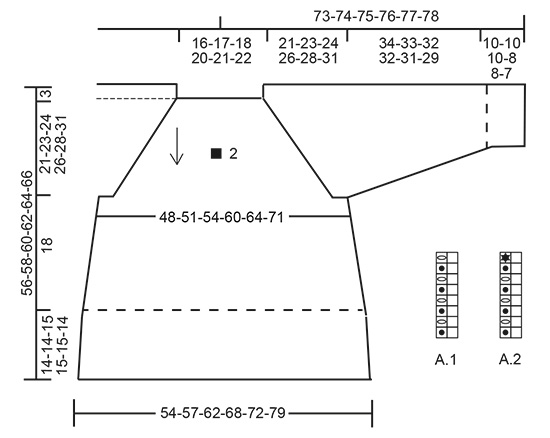 |
|||||||||||||||||||
 |
|||||||||||||||||||
Have you finished this pattern?Tag your pictures with #dropspattern #lastdaysofautumnsweater or submit them to the #dropsfan gallery. Do you need help with this pattern?You'll find 18 tutorial videos, a Comments/Questions area and more by visiting the pattern on garnstudio.com. © 1982-2025 DROPS Design A/S. We reserve all rights. This document, including all its sub-sections, has copyrights. Read more about what you can do with our patterns at the bottom of each pattern on our site. |
|||||||||||||||||||







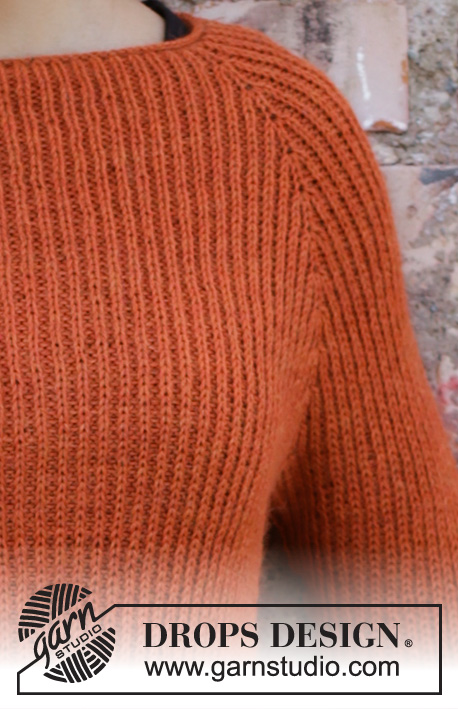

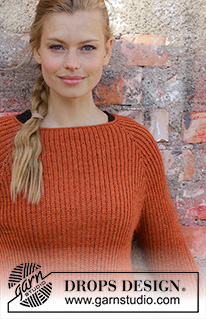
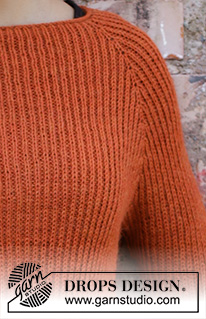







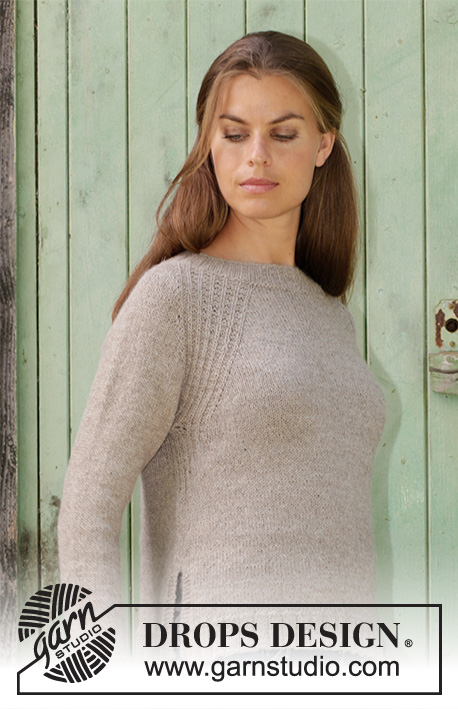
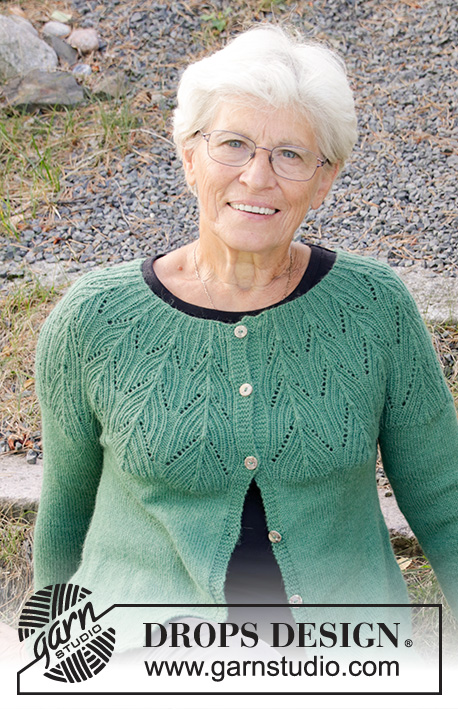


























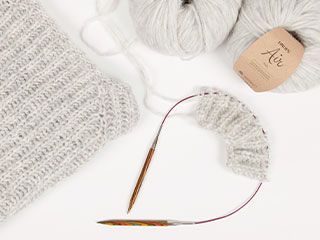












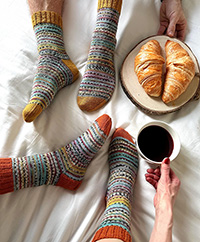
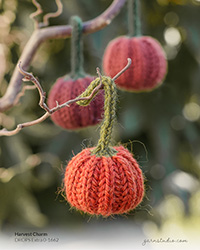



Post a comment to pattern DROPS 197-2
We would love to hear what you have to say about this pattern!
If you want to leave a question, please make sure you select the correct category in the form below, to speed up the answering process. Required fields are marked *.